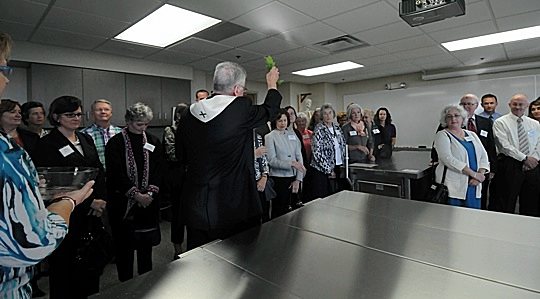
St. Catherine University students and professors will approach cadaver study with faith, ‘deep gratitude’
St. Catherine University student Lindsey Kolnick discovered that an anatomy textbook tells only part of the story. Now, as she seeks real-life knowledge about the human body, the student in the school’s doctorate of physical therapy program is among the first to work in its new human anatomy lab, the second largest of its kind in Minnesota.
“We have the invaluable gift of being able to continue our anatomy education right here on campus,” Kolnick said. “Having access to these anatomy labs affords us the opportunity to work hands-on with the human body, teaching us so much more than we could learn from any book.”
On Sept. 19, Archbishop John Nienstedt blessed the 3,600-square-foot anatomy lab on the University’s St. Paul campus at a service and reception for financial contributors to the lab’s construction.
Comprising two separate labs — one that will serve more than 500 students in eight St. Catherine programs this year and another for students in the physician’s assistant program the university plans to introduce next year — the new anatomy lab space draws attention to the scientific benefits of educating future professionals and also the faith dimensions of respecting and caring for the bodies of human donors.
Faith meets science
The anatomy lab blessing highlighted the complementarity of science and faith, Archbishop Nienstedt said.
“It’s our faith that really gives us the profound reverence and respect that we have for each human person as a son or daughter of God,” he said. “And the science helps us, it leads us to foster [and] promote the discovery of that human body — what makes it tick, what makes it run — and to promote, in the end, therapies for healing and discoveries that will give us new insights into how we can live better.”
The anatomy lab represents a new expression of St. Catherine’s teaching mission, in that it’s now located on its campus, said St. Catherine University President Andrea Lee, IHM, who also acknowledged the spiritual and ethical issues that are involved.
“Our students, our professors and, indeed, all of us will approach this work with honor and reverence, with faith and careful thought, with humility and deep gratitude,” she said.
Many windows offer abundant natural light in the anatomy labs, which have combined space for 18 cadavers; the lab currently in use has six. The lab space is part of a $1.1 million remodeling project on Mendel Hall’s fourth floor.
Students should have the same experience in the new lab as in the University of Minnesota’s lab where St. Catherine students previously did anatomy lab work, said Cort Cieminski, DPT associate professor and anatomy lab director. The need for the lab arose in 2010 when the University of Minnesota informed St. Catherine it could only accommodate its students for one more year.
One of the new anatomy lab’s benefits is that students will be able to learn from students, said Penelope Moyers, dean of the Henrietta Schmoll School of Health.
“It’s the interaction that’s going to occur not only among faculty and students but students to students, future professionals to future professionals,” Moyers said. “That in itself forms the foundation of how to work with one another.”
Church supports research
The Catholic Church, which has permitted medical research autopsies since the Middle Ages, instructs that there be a decorum in the treatment of human bodies, said Paul Wojda, an associate professor of theology at the University of St. Thomas who teaches a bioethics course.
“The efforts to communicate the importance of the donation, of the gift, I would say that’s probably in some ways the most important thing, especially in a Catholic context where we understand all of creation is gift,” he said.
According to the Catechism of the Catholic Church, “The bodies of the dead must be treated with respect and charity, in faith and hope of the Resurrection” (CCC No. 2300).St. Catherine plans to hold a religious service for students in the anatomy lab at the start of each semester.
The chance to help advance medical study for future generations at St. Catherine was one reason Peter and Patricia Frechette decided to contribute to the lab’s construction. The anatomy lab will be important for the University’s new physician’s assistant program and for its nursing program, said Patricia, who with her husband attends the Basilica of St. Mary in Minneapolis.
Having the anatomy lab on campus will benefit the entire university, Cieminiski said.
“It is a great opportunity, one that we are so very thankful for on a day-to-day basis to have,” he said. “We are wonderfully made. It’s not an accident that this tissue sits next to this tissue and it’s meant to do a certain function in life. And what a joy to be able to [study] that in our own facility here.”



